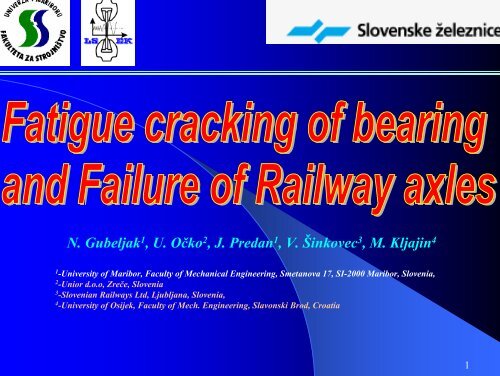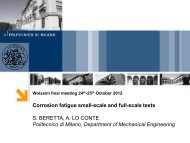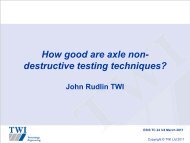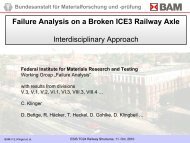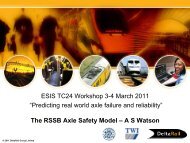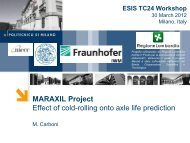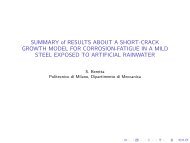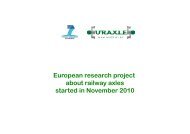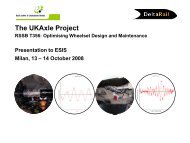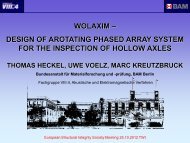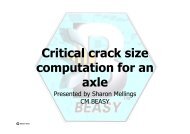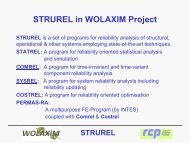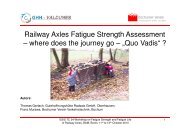Fatigue cracking of bearing and failure of railway axles - Integrity of ...
Fatigue cracking of bearing and failure of railway axles - Integrity of ...
Fatigue cracking of bearing and failure of railway axles - Integrity of ...
You also want an ePaper? Increase the reach of your titles
YUMPU automatically turns print PDFs into web optimized ePapers that Google loves.
N. Gubeljak 1 , U. Očko 2 , J. Predan 1 , V. Šinkovec 3 , M. Kljajin 4<br />
1-University <strong>of</strong> Maribor, Faculty <strong>of</strong> Mechanical Engineering, Smetanova 17, SI-2000 Maribor, Slovenia,<br />
2-Unior d.o.o, Zreče, Slovenia<br />
3-Slovenian Railways Ltd, Ljubljana, Slovenia,<br />
4-University <strong>of</strong> Osijek, Faculty <strong>of</strong> Mech. Engineering, Slavonski Brod, Croatia<br />
1
Motivation<br />
Case 1: The wagon’s <strong>bearing</strong> <strong>and</strong> axle wer distroyed <strong>and</strong> about<br />
8km <strong>of</strong> <strong>railway</strong> line were ruined!<br />
Wear <strong>of</strong> inner surface <strong>of</strong> the inner<br />
<strong>bearing</strong>’s ring due to the sliding <strong>of</strong><br />
the axle in it. Demaged inner <strong>bearing</strong> <strong>of</strong> the axle!
Motivation<br />
Case 1: The wagon’s <strong>bearing</strong> <strong>and</strong> axle wer distroyed <strong>and</strong> about<br />
8km <strong>of</strong> <strong>railway</strong> line were ruined!<br />
Demaged inner <strong>bearing</strong> <strong>and</strong> axle box housing!
Motivation!<br />
Failure occured on a freight wagon!<br />
Wagon had been in service for about 30 years!<br />
New <strong>bearing</strong> since five years ago!
MOTIVATION<br />
Case 2 (a few months later): Examination shows the inner reangs<br />
<strong>of</strong> both <strong>bearing</strong> wer broken!<br />
The axle <strong>and</strong> the damaged inner ring on<br />
inner <strong>bearing</strong>.<br />
Fracture <strong>of</strong> the inner ring <strong>of</strong> outer <strong>bearing</strong>.
Motivation<br />
Pitting <strong>of</strong> inner ring <strong>of</strong> outer <strong>bearing</strong> <strong>of</strong> freight wagon axle!
Motivation<br />
Pitting <strong>of</strong> inner ring <strong>of</strong> outer <strong>bearing</strong> <strong>of</strong> freight wagon axle!
Freight wagon axle!<br />
M 90<br />
Ø120<br />
5<br />
179<br />
226,5<br />
Ø146<br />
79<br />
Ø185<br />
10<br />
185<br />
Motivation<br />
Ø160<br />
1250<br />
1998<br />
2251<br />
R75<br />
R15<br />
R40<br />
226,5
Motivation<br />
Wheel-pair <strong>bearing</strong> <strong>of</strong> the freight wagon!
Pleminar Investigation<br />
All components <strong>of</strong> wagon are design for permanent dynamic loading:<br />
Number <strong>of</strong> load cycles (speed) <strong>of</strong> rail’s components such as <strong>axles</strong>,<br />
<strong>bearing</strong>s, wheels should be 2 x 10 8 cycles, it is more than 10 6 , as<br />
permanent dynamic strength, it is in the range <strong>of</strong> giga cycles<br />
Deviation from the assumed surface components, due to the impact on the<br />
surface. The surface cracks occur up to two millimeters in depth. In addition,<br />
the damaged corrosion’s protective layer, resulting in further growth <strong>of</strong> cracks<br />
through the cross-section<br />
Complex loads are more stochastic than envisaged at design <strong>and</strong><br />
testing <strong>of</strong> single components..<br />
Irregularities in the assembly can lead to addditonal tension load<br />
higher than assumed
Pleminar Investigation<br />
On the wagon, which was to derail the investigation was carried out on<br />
the damaged shaft <strong>and</strong> <strong>bearing</strong>. It was carried out a visual examination,<br />
chemical analysis <strong>of</strong> the shaft, the shaft tensile tests, hardness test shafts<br />
<strong>and</strong> <strong>bearing</strong>s <strong>and</strong> microscopic metallographic investigation <strong>of</strong> theshaft<br />
<strong>and</strong> <strong>bearing</strong><br />
An investigation has been a finding that the <strong>failure</strong> occurred due to<br />
damage to the <strong>bearing</strong> shaft.<br />
The heat <strong>of</strong> the shaft, the <strong>bearing</strong> inner ring, rollers <strong>and</strong> cages exceeded<br />
+1000 ˚ C <strong>and</strong> melted <strong>bearing</strong> <strong>and</strong> <strong>bearing</strong> housing melted, causing the<br />
damage <strong>of</strong> rail’s trial.<br />
The final decision <strong>of</strong> the investigation was that the first fatigue crack<br />
occurred in the internal ring, where it was exceeded long-term operation <strong>of</strong><br />
the dynamic load capacity <strong>of</strong> the ri.
Problem:<br />
Fracture <strong>of</strong> the housing roller inner ring <strong>of</strong> the burst, which is<br />
mounted on varicose nasedom axle shaft rate doubles!
Tensile tests
Tensile properties <strong>of</strong> <strong>bearing</strong> material<br />
Napetost (N/mm 2 )<br />
Stress<br />
1600<br />
1400<br />
1200<br />
1000<br />
800<br />
600<br />
400<br />
200<br />
Yield stress R p0.2 = 1100Nmm 2<br />
UTS R m = 1401Nmm 2<br />
0<br />
Tensile strength from σ-ε plot<br />
0 0,001 0,002 0,003 0,004 0,005 0,006 0,007 0,008<br />
2<br />
Deformacija<br />
Strain, -<br />
R p<br />
Meritev<br />
Aproksimacija<br />
Linearna (E)<br />
R m
Fracture mechanics toughness testing
<strong>Fatigue</strong> pre-<strong>cracking</strong> pre <strong>cracking</strong> by four bending<br />
• Maximum force <strong>of</strong> four bending fatigue:<br />
2 2<br />
2,52×B×(W-a) 2,52×10×(10-4)<br />
P = ×R = ×1100=15023,5N<br />
f p<br />
3×(S -S ) 3×(52,5-14,15)<br />
1 2<br />
F =0,1×F =0,1×9014=901,4N<br />
min max<br />
F =0,6×P =0,6×15023=9014N<br />
max f<br />
F<br />
F
Fracture mechanics toughness testing<br />
• Three point bending:<br />
F<br />
<strong>Fatigue</strong> crack after test!<br />
No stable crack extension!
Fracture mechanics toughness testing<br />
Force<br />
Sila (kN)<br />
2<br />
1,8<br />
1,6<br />
1,4<br />
1,2<br />
1<br />
0,8<br />
0,6<br />
0,4<br />
0,2<br />
0<br />
0 0,003 0,006 0,009 0,012 0,015 0,018 0,021 0,024 0,027 0,03<br />
CMOD (mm)<br />
F-CMOD plot shows plane strain conditions!<br />
P Q =P max<br />
F, kN<br />
95%<br />
Linearno (F, kN)
Fracture mechanics toughness testing<br />
• SIF calculation<br />
⎛ P×S ⎞ ⎛ 1764,1×52,5 ⎞<br />
K = ⎜ ⎟×f(a/W)= ⎜ ⎟×2,0043=587N/mm<br />
⎝ ⎠<br />
mat<br />
Q<br />
1/2 3/2<br />
⎝(B×B ) ×W N ⎠<br />
1/2 3/2<br />
(10×10) ×10<br />
[ ]<br />
1/2 2<br />
3×(a/W) × 1,99-(a/W)×(1-(a/W)×(2,15-3,93×(a/W)+2,7×(a/W) )<br />
a /W)= =<br />
i 3/2<br />
2×(1+2×a/W)×(1-a/W)<br />
[ ]<br />
1/2 2<br />
3×(4/10) × 1,99-(4/10)×(1-(4/10)×(2,15-3,93×(4/10)+2,7×(4/10) )<br />
a /W)= =2,00438<br />
i 3/2<br />
2×(1+2×4/10)×(1-4/10)<br />
a [mm] -crack length<br />
P Q [N] -Force <strong>of</strong> <strong>failure</strong><br />
S [N] -span distance<br />
B [mm] -thickness <strong>of</strong> specimen<br />
W [mm] -width <strong>of</strong> specimen<br />
3/2
Stress in inner ring induced by rollers<br />
Two extreme conditions are going to analysis!<br />
tion <strong>of</strong> ring!<br />
A<br />
A<br />
Crack is between two rollers!<br />
F<br />
Section <strong>of</strong> ring<br />
A<br />
A<br />
Crack is bellow roller!<br />
F
Stress distribution through the section<br />
Stress<br />
Rolling<br />
surface<br />
x<br />
Thickness <strong>of</strong> ring<br />
Crack is between two rollers!<br />
σ t obr<br />
σ zz<br />
σ xy<br />
σ r obr<br />
von Mises<br />
Axle
Stress distribution through the section<br />
Stress<br />
x<br />
Rolling<br />
surface<br />
Thickness <strong>of</strong> ring<br />
Crack is bellow roller!<br />
von Mises<br />
σ obr<br />
t<br />
σxy σ r obr<br />
σ zz<br />
Axle
Stress distribution through the section<br />
T<br />
p = 0<br />
p = 23.4Mpa<br />
Distribution <strong>of</strong> press fit stresses (σ t ) in case <strong>of</strong> overlap <strong>of</strong> 0,074 mm.
Analysis <strong>of</strong> results<br />
• Calculation <strong>of</strong> the <strong>bearing</strong> is made at SINTAP procedure (Structural <strong>Integrity</strong><br />
Assessment Procedures) - a procedure to ensure the integrity <strong>of</strong> structures.<br />
• The crack in the inner ring is deemed as a radial surface cracks in the cylinder<br />
wall.<br />
•Included are two different points on the crack on the surface <strong>and</strong> inside.<br />
• The calculations take account <strong>of</strong> tensions due to the burden <strong>and</strong> tension<br />
compression joints.<br />
Included are different values <strong>of</strong> the surplus between the axis <strong>and</strong> the inner ring bearin<br />
• Simulated two different situations depending on the crack roller <strong>and</strong> thus provides<br />
for two different stress intensity factor K I <strong>and</strong> K II.
K I (N/mm 1,5 )<br />
120<br />
118<br />
116<br />
114<br />
112<br />
110<br />
108<br />
106<br />
104<br />
102<br />
100<br />
Analysis <strong>of</strong> results<br />
1 2 3 4 5 6<br />
1<br />
K Imax<br />
2<br />
K Imin<br />
0 60 120 180 240 300 360<br />
Distribution <strong>of</strong> SIF K I .<br />
3<br />
4<br />
Rotacija Rotation notranjega<br />
<strong>of</strong> axle!<br />
obroča<br />
Rotacija Rotation valjčka <strong>of</strong> roller<br />
Rotation angle(˚)<br />
K Imax<br />
5<br />
6
K II (N/mm 1,5 )<br />
-0,2<br />
-0,5<br />
-0,8<br />
-1,1<br />
-1,4<br />
-1,7<br />
-2<br />
Analysis <strong>of</strong> results<br />
K IImax =K IIimin<br />
0 60 120 180 240 300 360<br />
Distribution <strong>of</strong> SIF K II.<br />
Angle (˚)
F<br />
Analysis <strong>of</strong> results<br />
Razpoka na<br />
notranjem obroču<br />
Razpoka na<br />
notranjem obroču<br />
Crack between rollers Crack below roller<br />
Two different position <strong>of</strong> roller regarding to surface crack<br />
Geometry <strong>of</strong> the crack caused by pitting!<br />
F
SIF K 1<br />
Application <strong>of</strong> Fracture mechanics<br />
K= I<br />
3 a 2c R i<br />
π×a∑σ×f( , , )<br />
i i<br />
i=0 t a t<br />
a[mm] -crack depth<br />
t[mm] -thickness <strong>of</strong> ring<br />
2c[mm] -crack length <strong>of</strong> surface<br />
Ri [mm]<br />
σ[N/mm<br />
-inner radius <strong>of</strong> ring<br />
2 98<br />
96<br />
94<br />
92<br />
90<br />
88<br />
] -stress through thickness <strong>of</strong> ring<br />
Maximum SIF K IAmax in point A:<br />
K = π×a×(σ ×f +σ ×f +σ ×f +σ ×f )<br />
IAmax 0 0 1 1 2 2 3 3<br />
σ,σ,σ,σ obr kr<br />
0 1 2 3<br />
f 0,f 1,f 2,f 3<br />
[N/mm2 ] -aproximation parametrs (σ +σ )<br />
t t<br />
-from SINTAP h<strong>and</strong>book for point A<br />
Napetost (N/mm 2 )<br />
102<br />
100<br />
(σ t obr + σt kr )<br />
0 1 2 3 4 5 6 7 8 9 10 11 12 13 14 15<br />
Položaj na obroču (mm)
Application <strong>of</strong> Fracture mechanics<br />
Minimum SIF K IAmin in point A.<br />
K = π×a×(σ ×f +σ ×f +σ ×f +σ ×f )<br />
1Amin 0 0 1 1 2 2 3 3<br />
Napetost (N/mm 2 )<br />
120<br />
100<br />
80<br />
60<br />
40<br />
20<br />
0<br />
σ t kr<br />
0 2 4 6 8 10 12 14
M×τ× π×a<br />
2 K= II<br />
Φ<br />
[ ] 1/2<br />
1.64<br />
Φ= 1+1,464(a/c)<br />
Calculation <strong>of</strong> SIF in point A<br />
M 2 -coeficient <strong>of</strong> geometry<br />
τ [N/mm 2 ] - shear stress in inner ring<br />
a [mm] -crack depth<br />
c [mm] -half <strong>of</strong> crack length
Maksimum value <strong>of</strong> SIF K IIAmax at point A.<br />
M×τ × π×a<br />
2 max<br />
K =<br />
IIAmax<br />
Φ<br />
[ ] 1/2<br />
1.64<br />
Φ= 1+1.464(a/c)<br />
τ =σ +σ<br />
kr<br />
max r xy<br />
Calculation <strong>of</strong> SIF in point A<br />
M2 [N/mm2 ]<br />
[N/mm<br />
- coeficient <strong>of</strong> geometry<br />
2 ] -maximum shear stress in inner ring<br />
a[mm] -crack depth<br />
c[mm] -hal <strong>of</strong> crack length on surface<br />
σ kr<br />
r [N/mm2 ] -radial stress <strong>of</strong> press fit<br />
σxy [N/mm2 τ max<br />
] -shear stress caused by loading <strong>of</strong> <strong>bearing</strong>
Minimal value <strong>of</strong> SIF K IIAmin at point A.<br />
M×τ × π×a<br />
2 min<br />
K = IIAmin<br />
Φ<br />
τ =σ min r<br />
kr<br />
τ<br />
min<br />
[N/mm 2 ] - minimal shear sress in inner ring!<br />
Ker je σ = 0 ⇒ τ = τ ⇒ K = K<br />
xy max min IIAmax IIAmin<br />
T<br />
2B<br />
Calculation <strong>of</strong> SIF at point A<br />
a<br />
2H<br />
A<br />
φ<br />
φ c<br />
A<br />
φ<br />
φ c<br />
B<br />
B
K = π×a×(σ ×f +σ ×f +σ ×f +σ ×f )<br />
IBmax 0 0 1 1 2 2 3 3<br />
Minimum at point B.<br />
Calculation <strong>of</strong> SIF at point B<br />
K = π×a×(σ ×f +σ ×f +σ ×f +σ ×f )<br />
IBmin 0 0 1 1 2 2 3 3
Relevant for both modes B.<br />
K = K +K<br />
2 2<br />
prim(B)max IBmax IIBmax<br />
K = K +K<br />
2 2<br />
prim(B)min IBmin IIBmin<br />
SIF in point B
Limit load:<br />
σ σ<br />
gζ ( ) ⋅ + g( ζ) ⋅ + (1 −ζ) ⋅σ<br />
max<br />
=<br />
3 9<br />
r<br />
2<br />
(1 −ζ) ⋅Rp<br />
1<br />
σ = ⋅( σ −σ<br />
)<br />
b<br />
1 2<br />
2<br />
1<br />
σ = ⋅ ( σ + σ )<br />
m<br />
1 2<br />
2<br />
3 0.75<br />
( ) 1 20 ( )<br />
a<br />
gζ = − ⋅ζ⋅ l<br />
al ⋅<br />
ζ =<br />
T⋅ ( l+ 2 ⋅T)<br />
σ<br />
σ<br />
R<br />
b<br />
m<br />
p<br />
Estimation <strong>of</strong> Struc. <strong>Integrity</strong><br />
b 2<br />
2<br />
b<br />
2 2<br />
m<br />
[N/mm 2 ] - bending stress<br />
[N/mm 2 ] - membrane stress<br />
[N/mm 2 ] - yield stress<br />
σ 1<br />
f(σ t obr + σt kr )<br />
σ 2<br />
σ 2
−1/2<br />
⎡ 1 ⎤<br />
f( L ) =<br />
⎢<br />
1+ ⋅L ⋅ 0,3+ 0,7⋅exp( −µ ⋅L<br />
⎣ 2 ⎥⎦<br />
[ ]<br />
2 6<br />
r r r<br />
⎧ E<br />
⎪0,001⋅<br />
µ = min ⎨ Rp<br />
⎪⎩ 0,6<br />
( N 1)<br />
2⋅N<br />
= = ⋅<br />
r r r<br />
f( L) f( L 1) L −<br />
N<br />
L<br />
r max<br />
⎡ R ⎤ p<br />
= 0,3 ⋅⎢1− R<br />
⎥<br />
⎣ m ⎦<br />
1 ⎡R⋅R⎤ p m<br />
= ⋅⎢ ⎥<br />
2 ⎣ Rp<br />
⎦<br />
za<br />
FAC<br />
1 ≤ L ≤ L<br />
r r<br />
max<br />
za<br />
0≤L≤1 r
Structure assessment <strong>of</strong> inner ring<br />
K r, f(L r )<br />
Kr<br />
1,2<br />
1,1<br />
1<br />
0,9<br />
0,8<br />
0,7<br />
0,6<br />
0,5<br />
0,4<br />
0,3<br />
0,2<br />
0,1<br />
0<br />
K r , B<br />
K r,A<br />
f(Lr)<br />
0 0,1 0,2 0,3 0,4 0,5 0,6 0,7 0,8 0,9 1 1,1<br />
Lr =σref /σy FAD- overlap <strong>of</strong> 0,037 mm for crack depth a=15mm.<br />
f(Lr)<br />
Točka A<br />
Point<br />
Točka B
Structure assessment <strong>of</strong> inner ring<br />
K r, , f(L r )<br />
Kr<br />
1,2<br />
1,1<br />
1<br />
0,9<br />
0,8<br />
0,7<br />
0,6<br />
0,5<br />
0,4<br />
0,3<br />
0,2<br />
0,1<br />
0<br />
K r , B<br />
0 0,1 0,2 0,3 0,4 0,5 0,6 0,7 0,8 0,9 1 1,1<br />
Lr =σref /σy FAD-overlap <strong>of</strong> 0,05 mm.<br />
K r,A<br />
f(Lr)<br />
f(Lr)<br />
Točka Point<br />
A<br />
Točka B
Structure assessment <strong>of</strong> inner ring<br />
K r , f(L r )<br />
Kr<br />
1,2<br />
1,1<br />
1<br />
0,9<br />
0,8<br />
0,7<br />
0,6<br />
0,5<br />
0,4<br />
0,3<br />
0,2<br />
0,1<br />
0<br />
K r , B<br />
K r,A<br />
f(Lr)<br />
0 0,1 0,2 0,3 0,4 0,5 0,6 0,7 0,8 0,9 1 1,1<br />
FAD- overlap <strong>of</strong> 0,052 mm.<br />
f(Lr)<br />
Point<br />
Točka A<br />
Točka B<br />
L r =σ ref /σ y
Structure assessment <strong>of</strong> inner ring<br />
K r , f(L r )<br />
Kr<br />
1,2<br />
1,1<br />
1<br />
0,9<br />
0,8<br />
0,7<br />
0,6<br />
0,5<br />
0,4<br />
0,3<br />
0,2<br />
0,1<br />
0<br />
K r , B<br />
K r,A<br />
f(Lr)<br />
0 0,1 0,2 0,3 0,4 0,5 0,6 0,7 0,8 0,9 1 1,1<br />
FAD- overlap <strong>of</strong> 0,074 mm.<br />
f(Lr)<br />
Točka Point<br />
A<br />
Točka B<br />
L r =σ ref /σ y
Structure assessment <strong>of</strong> inner ring<br />
K r , f(L r )<br />
Kr<br />
Kr<br />
1,2<br />
1,2<br />
1,1 1,1<br />
1<br />
0,9 0,9<br />
0,8<br />
0,7<br />
0,6<br />
0,5<br />
0,4<br />
K r , B<br />
0,3<br />
0,2<br />
0,1 0,1<br />
0<br />
0 0,1 0,2 0,3 0,4 0,5 0,6 0,6 0,7 0,7 0,8 0,8 0,9 0,9 1 1 1,1 1,1<br />
FAD-overlap <strong>of</strong> 0,1 mm.<br />
K r,A<br />
f(Lr)<br />
f(Lr)<br />
Točka Point<br />
f(Lr) A<br />
Točka BA<br />
Točka B<br />
L r =σ ref /σ y σ
Structure assessment <strong>of</strong> inner ring<br />
Critical crack length regarding to ovelaping<br />
PRESEŽEK δ=0,037 δ=0,05 δ=0,052 δ=0,055 δ=0,06 δ=0,074 δ=0,1 δ=0,15<br />
ac (mm) - - 15 14,6 14,3 12,5 9 5,5
1<br />
Press stress has not effect to crack.<br />
Dangerous for <strong>failure</strong>.<br />
Discussion<br />
Press stress causes crack propagation<br />
0,000 0,030 0,060 0,090 0,120 0,150<br />
0,037 0,052<br />
Safe service<br />
Appropriate overlaping!<br />
Fail <strong>of</strong> inner ring.<br />
0,037 0,074<br />
Reality?<br />
Overlap (mm)<br />
Prescribed by SŽ
Analysis<br />
The size <strong>of</strong> the surplus gap dl.<br />
The size <strong>of</strong> the surplus gap regarding to overlap δ.<br />
δ (mm) aC (mm) dl (mm)<br />
0,037 - 0,11618<br />
0,05 - 0,157<br />
0,052 15 0,16328<br />
0,055 14,6 0,1727<br />
0,06 14,3 0,1884<br />
0,074 12,5 0,23236<br />
0,1 9 0,314<br />
F
Conclusion<br />
The purpose <strong>of</strong> the work was to determine factors that affect the function <strong>of</strong><br />
<strong>bearing</strong> <strong>failure</strong> at the rate <strong>of</strong> freight <strong>railway</strong> vehicle axle.<br />
On the basis <strong>of</strong> the checks <strong>bearing</strong> <strong>failure</strong> is found that fracture occurs by the<br />
breakage <strong>of</strong> the <strong>bearing</strong> inner ring, which is mounted as press fit.<br />
In some cases, the <strong>bearing</strong> can have through crack, but inner ring still operates.<br />
It is possible in a manner that press force is adequate not too high <strong>and</strong> the rolling<br />
rollers rotate normally.<br />
On the other h<strong>and</strong>, it happened that there was a burst <strong>of</strong> <strong>bearing</strong> ring, rollers <strong>and</strong><br />
housing are overheating <strong>and</strong> rail car derailment.<br />
Thus, the immediate aim <strong>of</strong> the study was to determine the reasons which lead<br />
to a limited two-destructive state <strong>of</strong> the internal ring, namely the functional<br />
operation <strong>of</strong> the <strong>bearing</strong> or <strong>bearing</strong> <strong>failure</strong>.
The analysis shows that the inner tension ring, which is due to press fit is crucial<br />
for the integrity <strong>of</strong> the internal ring with a crack.<br />
Indeed, a sufficiently low tolerance overlaping between ring <strong>and</strong> axle the size <strong>of</strong><br />
the surplus gap will be enough small that rollers <strong>and</strong> <strong>bearing</strong> can be still in use<br />
even a crack will be through whole ring.<br />
In the case <strong>of</strong> excessive tension stresses, the ring is going to open <strong>and</strong> the rollers<br />
wedged into a crevice, <strong>and</strong> thus lead to <strong>bearing</strong> <strong>failure</strong> <strong>and</strong> the derailment <strong>of</strong> the<br />
vehicle. However, it must be oversized enough to prevent the rotation <strong>of</strong> the inner<br />
ring at the rate axis but not to high that crack in inner <strong>bearing</strong>’s ring has to large<br />
gap.
Thank you for your attention!


